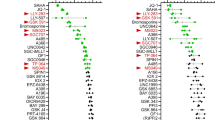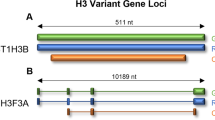Abstract
Diffuse intrinsic pontine glioma (DIPG) is a fatal childhood cancer. We performed a chemical screen in patient-derived DIPG cultures along with RNA-seq analyses and integrated computational modeling to identify potentially effective therapeutic strategies. The multi–histone deacetylase inhibitor panobinostat demonstrated therapeutic efficacy both in vitro and in DIPG orthotopic xenograft models. Combination testing of panobinostat and the histone demethylase inhibitor GSK-J4 revealed that the two had synergistic effects. Together, these data suggest a promising therapeutic strategy for DIPG.
This is a preview of subscription content, access via your institution
Access options
Subscribe to this journal
Receive 12 print issues and online access
$209.00 per year
only $17.42 per issue
Buy this article
- Purchase on Springer Link
- Instant access to full article PDF
Prices may be subject to local taxes which are calculated during checkout


Similar content being viewed by others
Change history
15 June 2015
In the version of this article initially published online, there were four typographical errors in the manuscript text. The errors have been corrected in the PDF and HTML versions of this article.
References
Donaldson, S.S., Laningham, F. & Fisher, P.G. J. Clin. Oncol. 24, 1266–1272 (2006).
Monje, M. et al. Proc. Natl. Acad. Sci. USA 108, 4453–4458 (2011).
Hashizume, R. et al. J. Neurooncol. 110, 305–313 (2012).
Wu, G. et al. Nat. Genet. 44, 251–253 (2012).
Schwartzentruber, J. et al. Nature 482, 226–231 (2012).
Khuong-Quang, D.A. et al. Acta Neuropathol. 124, 439–447 (2012).
Lewis, P.W. et al. Science 340, 857–861 (2013).
Bender, S. et al. Cancer Cell 24, 660–672 (2013).
Caretti, V. et al. Acta Neuropathol. 127, 897–909 (2014).
Taylor, K.R. et al. Nat. Genet. 46, 457–461 (2014).
Veringa, S.J. et al. PLoS ONE 8, e61512 (2013).
Pal, R. & Berlow, N. In Pacific Symposium on Biocomputing 351–362 (2012).
Berlow, N. et al. BMC Bioinformatics 14, 239 (2013).
Bradner, J.E. et al. Nat. Chem. Biol. 6, 238–243 (2010).
Brown, Z.Z. et al. J. Am. Chem. Soc. 136, 13498–13501 (2014).
Chan, K.M. et al. Genes Dev. 27, 985–990 (2013).
Sandberg, D.I., Edgar, M.A. & Souweidane, M.M. J. Neurosurg. 96, 885–891 (2002).
Hashizume, R. et al. Nat. Med. 20, 1394–1396 (2014).
Sturm, D. et al. Cancer Cell 22, 425–437 (2012).
Sewing, A.C. et al. J. Neurosci. Methods 238, 88–94 (2014).
Grasso, C.S. et al. Nature 487, 239–243 (2012).
Langmead, B., Trapnell, C., Pop, M. & Salzberg, S.L. Genome Biol. 10, R25 (2009).
Ng, S.B. et al. Nature 461, 272–276 (2009).
Lonigro, R.J. et al. Neoplasia 13, 1019–1025 (2011).
Mortazavi, A., Williams, B.A., McCue, K., Schaeffer, L. & Wold, B. Nat. Methods 5, 621–628 (2008).
Acknowledgements
We thank the many children and families who selflessly contributed to this study through tissue donations obtained from surgery or autopsy, and A. Gajjar for his guidance and vision throughout this study. We also thank D. Hargrave, J. Olson and S. Leary for selection of V.2 chemical screen agents. We are grateful for the critical questions and comments by S. Cheetham and N. Nsouli. We also acknowledge important comments by another DIPG Preclinical Consortium member, O. Becher. We thank G. Grant for assistance in developing rodent CED techniques. We thank R. Hashizume and C.D. James (Northwestern University) for use of the SF7761 DIPG cell line. Short-read sequencing was performed by the OHSU Massively Parallel Sequencing Shared Resource. This research is supported by the Lyla Nsouli Foundation, the Children's Oncology Group (COG) Central Nervous System Committee, the DIPG Collaborative (The Cure Starts Now Foundation, Reflections of Grace Foundation, Smiles for Sophie Foundation, Cancer-Free Kids Foundation, Carly's Crusade Foundation, Jeffrey Thomas Hayden Foundation, Soar with Grace Foundation), the Accelerate Brain Cancer Cures Foundation (ABC2), CureSearch for Childhood Cancer, the Team Julian Foundation and the COG Chair's Grant (5UOCA098543). Additional funding support was provided by US National Institutes of Health grant K08NS070926 (to M.M.), Alex's Lemonade Stand Foundation (to M.M. and Y.T.), the McKenna Claire Foundation, the Connor Johnson Memorial Fund, the Dylan Jewett Memorial Fund, the Elizabeth Stein Memorial Fund, the Dylan Frick Memorial Fund, the Abigail Jensen Memorial Fund, the Zoey Ganesh Memorial Fund, the Wayland Villars DIPG Foundation, the Jennifer Kranz Memorial Fund, Unravel Pediatric Cancer, the Virginia & D.K. Ludwig Fund for Cancer Research, the Price Family Charitable Fund, the Matthew Larson Foundation, the Godfrey Family Fund in Memory of Fiona Penelope, the Child Health Research Institute at Stanford, the Anne T. and Robert M. Bass Endowed Faculty Scholarship in Pediatric Cancer and Blood Diseases (all to M.M.), Etoile de Martin (to J.G. and N.T.), Fondation Lemos and Le Défi de Fortunée (to J.G.), the Scott Carter Foundation (to N.E.B.), the Semmy Foundation (to D.G.v.V. and E.H.), the US Department of Defense (to X.-N.L.), National Science Foundation grant CCF0953366 (to R.P.), Marie Curie grant IRG270459 (to M.M.A.); the Spanish Ministry of Health grant PI13/0125 (to M.M.A.), and the St. Baldrick's Foundation and Iron Matt Foundation (both to E.R. and M.H.-C.).
Author information
Authors and Affiliations
Contributions
C.K., M.M., J.G., Y.T., M.F., K.E.W., D.G.v.V., R.P., C.S.G., C.H., X.-N.L. and P.T.S. participated in the design or interpretation of the reported experiments or results. J.A., E.H., L.L., Y.T., A.P., S.C., P.J.W., T.B.J., M.H.-C., L.L.D., N.T., M.M., K.E.W., R.P., N.E.B., L.E.D., E.H.R. C.K., M.K., Y.D., L.Q., Y.H., C.S.G., M.Q., M.-A.D., J.N., M.M.A., W.S., E.C.H., M.J.Q., P.S.M., H.M., M.N.S., N.W. and X.-N.L. participated in the acquisition or analysis of data. M.M., C.S.G., C.K., J.G., Y.T., M.-A.D., L.L., R.P., N.T., E.H.R., D.G.v.V., N.E.B. and X.-N.L. participated in drafting or revising the manuscript. M.M., C.K., R.P. and J.G. supervised all aspects of the research.
Corresponding authors
Ethics declarations
Competing interests
N.E.B., C.K., L.E.D. and R.P. have filed an invention disclosure with Texas Tech University for probabilistic Boolean modeling of predicted drug combinations and are in the process of commercializing this approach. A US patent application has also been filed.
Supplementary information
Supplementary Text and Figures
Supplementary Figures 1–10 and Supplementary Tables 1 and 5 (PDF 5837 kb)
Supplementary Table 2
STR fingerprints of the DIPG cell lines (XLSX 9 kb)
Supplementary Table 3
Sequencing statistics and identified mutations (XLSX 40 kb)
Supplementary Table 4
Calculated combination indices (XLSX 20 kb)
Rights and permissions
About this article
Cite this article
Grasso, C., Tang, Y., Truffaux, N. et al. Functionally defined therapeutic targets in diffuse intrinsic pontine glioma. Nat Med 21, 555–559 (2015). https://doi.org/10.1038/nm.3855
Received:
Accepted:
Published:
Issue Date:
DOI: https://doi.org/10.1038/nm.3855
This article is cited by
-
PRMT5 inhibition shows in vitro efficacy against H3K27M-altered diffuse midline glioma, but does not extend survival in vivo
Scientific Reports (2024)
-
Diffuse intrinsic pontine gliomas in pediatric patients: management updates
Egyptian Journal of Neurosurgery (2023)
-
Common molecular features of H3K27M DMGs and PFA ependymomas map to hindbrain developmental pathways
Acta Neuropathologica Communications (2023)
-
Spatially controlled construction of assembloids using bioprinting
Nature Communications (2023)
-
Superenhancers as master gene regulators and novel therapeutic targets in brain tumors
Experimental & Molecular Medicine (2023)



